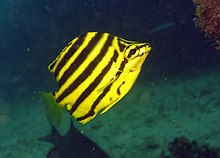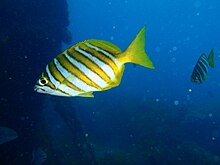Striped butterfly fish
| Striped butterfly fish | ||||||||||||
|---|---|---|---|---|---|---|---|---|---|---|---|---|

Yellowtail Steerbarsch ( Atypichthys latus ) |
||||||||||||
| Systematics | ||||||||||||
|
||||||||||||
| Scientific name | ||||||||||||
| Microcanthidae | ||||||||||||
| Johnson , 1984 |
The striped butterfly fish (Microcanthidae) are a species-poor family of marine fish from the order of the sunfish-like (Centrarchiformes).
distribution
Striped butterfly fish live in the moderately temperate and cool regions around South Australia and New Zealand , only one species, the Nagasaki fish ( Microcanthus strigatus ), also occurs in the North Pacific around Japan and Hawaii .
features
The animals are 16 to 40 centimeters long. Their high-backed or oval body is patterned by a whitish, silvery or yellow basic color and by horizontal, vertical or diagonal dark or yellow and dark edged stripes. The fins continue the stripe pattern or are transparent, yellow or dark. The fish are covered with small ctenoid scales, which can also be found on the "cheeks" and the upper part of the gill cover. The scales form a scaly sheath at the base of the dorsal and anal fin and extend to the soft-radiated sections of both fins. The sideline is continuous and slightly curved. The small mouth is terminal and does not extend to the rear edge of the eyes. The small, pointed teeth are closely grouped in a single row or are arranged in a wide band. The attachment of the pelvic fins is clearly behind the pectoral fin base. The caudal fin is indented or forked.
- Fin formula : Dorsal XI – XII / 16–18, Anale III / 16–19.

- From the butterfly fish (Chaetodon) of the tropical coral reefs, to which they look very similar, the striped butterfly fish can be distinguished by their caudal fin and the position of the pelvic fins. While the former is usually straight or rounded in the butterfly fish, it is indented or forked in the striped butterfly fish. The ventral fins of the butterfly fish are directly or almost below the pectoral fins, in the striped butterfly fish they are clearly behind. There is no closer relationship with the butterfly fish. Young striped butterfly fish have the eye spots typical of butterfly fish . However, the larvae are much slimmer than those of the butterfly fish and they do not have the head spines typical of the butterfly fish's tholichthys stage.
- The steerable fish (Kyphosidae) have incisor-like teeth, those of the striped butterflyfish are pointed. The dorsal and anal fins of the steerable perch have fewer soft rays than those of the striped butterflyfish (12 to 15 vs. 16 to 18 or 11 to 14 vs. 16 to 19).
- The brushfish (Scorpididae) have fewer hard rays in the dorsal fin than the striped butterfly fish (IX or X vs. XI to XII) but have more soft rays in the dorsal and anal fin than the striped butterfly fish (26 to 28 vs. 16 to 18 or 27 to 28 vs. 16 to 19). In addition, the hard-nosed section of the dorsal fin of the brushfish is noticeably lower than the soft-nosed section.
- The striped butterfly fish can be distinguished from the rodent perch (Girellidae) by their teeth. While the teeth of the striped butterflyfish are single-pointed, the teeth of the rodent perch in the outer row of teeth are usually three-pointed. With 13 to 16 spines and 11 to 14 soft rays, the rodent perches have more hard rays but fewer soft rays in the dorsal fin than the striped butterflyfish (11 to 12 or 16 to 18). The same applies to the anal fin (11 or 12 soft rays vs. 16 to 19).
Way of life
Striped butterfly fish usually live in small schools on rocky coasts and are mainly found in shallow water, in sheltered bays, in harbors under docks and in the surf zone. In contrast to the steerable perch, their diet is not primarily vegetarian, but mainly zooplankton or benthic invertebrates. But algae are also eaten. They are almost never found by divers below 25 meters, but trawls are also caught from a depth of several hundred meters.
Systematics
The Nagasaki fish was the first to be described by the French naturalist Georges Cuvier in 1831 . Eleven years later, the Scottish zoologist John Richardson described the six-banded striped butterflyfish. Both species are outwardly very similar to the butterfly fish and were assigned to the genus Chaetodon by the authors of the first descriptions , i.e. the butterfly fish. The striped butterflyfish were first introduced as an independent family in 1984 by the American ichthyologist G. David Johnson . The striped butterflyfish were later counted as a subfamily of the steerable perch (Kyphosidae) together with the brush perch and the rodent perch . Other writers continue to give them family rank.
Genera and species
There are four genera with six species:
- Genus Atypichthys Günther, 1862
- Yellow-tailed mudfish ( Atypichthys latus McCulloch & Waite, 1916 )
- Australian Mado ( Atypichthys strigatus (Günther, 1860) )
- Genus Microcanthus Swainson, 1839
- Microcanthus joyceae Whitley, 1931
- Nagasaki fish ( Microcanthus strigatus (Cuvier, 1831) )
- Genus Neatypus Waite, 1905
- Diagonal striped butterflyfish ( Neatypus obliquus Waite, 1905 )
- Genus Tilodon Thominot, 1881
- Six-banded striped butterflyfish ( Tilodon sexfasciatus (Richardson, 1842) )
supporting documents
- ↑ a b c d Helmut Debelius / Rudie H. Kuiter : Butterfly fish, Chaetodon . Ulmer Verlag, 2003, ISBN 3-8001-4243-0 . Page 194–205.
- ^ A b c d e f Kent E. Carpenter & Volker H. Niem: The Living Marine Resources of the Western Central Pacific. Volume 5. Bony fishes part 3 (Menidae to Pomacentridae). Rome, FAO. 1998, ISBN 92-5-104587-9 . Page 3301–3303.
- ^ G. David Johnson: Percoidei: Development and Relationships. in Ontogeny and systematics of fishes. Based on an International Symposium Dedicated to the Memory of Elbert Halvor Ahlstrom.
- ^ Joseph S. Nelson, Terry C. Grande, Mark VH Wilson: Fishes of the World. Wiley, Hoboken, New Jersey, 2016, ISBN 978-1118342336
- ↑ Microcanthinae on Fishbase.org (English)
- ↑ Tea, Y.-K. & Gill, AC (2020): Systematic reappraisal of the anti-equatorial fish genus Microcanthus Swainson (Teleostei: Microcanthidae), with redescription and resurrection of Microcanthus joyceae Whitley . Zootaxa, 4802 (1): 41-60. DOI: 10.11646 / zootaxa.4802.1.3


